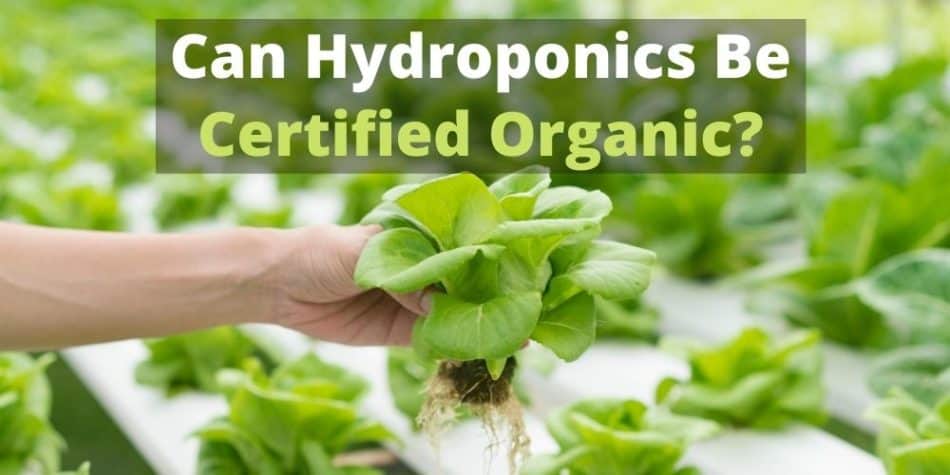Hydroponics are an efficient way to grow produce more quickly and with less water compared to soil. However, the question that gets frequently asked is whether hydroponics can be organic.
So can hydroponics be certified organic? Technically no, hydroponics can never be certified organic. According to the USDA “certified organic foods are grown and processed according to federal guidelines addressing…soil quality.” Since hydroponics does not use soil means it cannot be certified organic.
Can hydroponics be “organic” to what a regular person would refer to as not using synthetic pesticides, GMO’s, and all that factory farm stuff? Yes, hydroponics can be “organic” in the sense that it would be a plant that is grown using natural substances and without any synthetic additives.
What Really Is Organic Gardening?
The United States Department of Agriculture (USDA) has setup an organization called the National Organic Program (NOP) that is in charge of setting rules and regulations for something to be called organic.
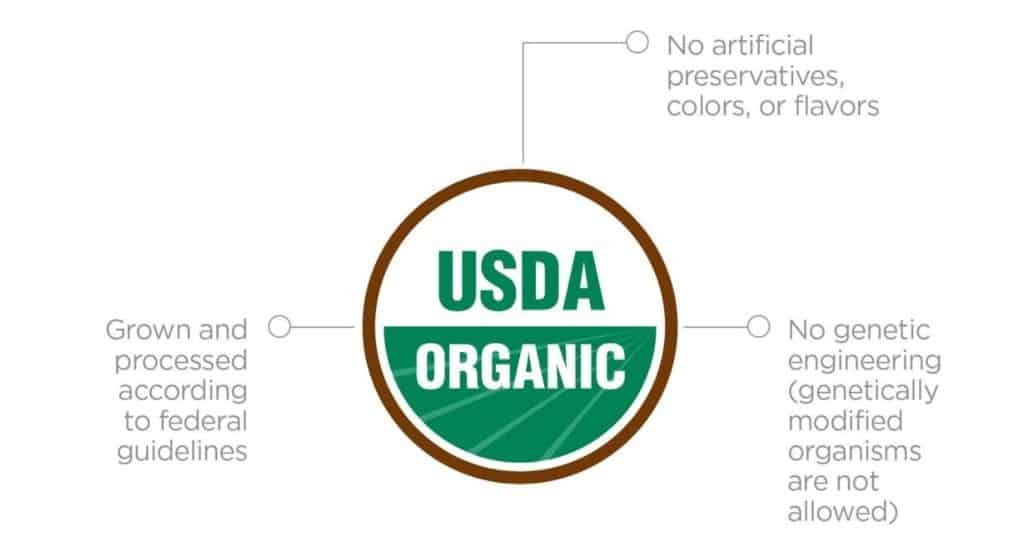
The goal of NOP is to certify that the organic produce you purchase in a store has:
- started from an organic seed or plant
- been planted in organic soil that does not have sewage sludge or biosolids
- minimal impact on the environment when growing
- not been sprayed with synthetic pesticides except for the few approved synthetic substances
All this means that the organic produce in the store has been grown with higher standards and therefore justifies the more expensive price.
Why Even Try Organic Hydroponics?
Doing hydroponics organically does not require that much more work versus doing hydroponics the conventional way in concept.
Looking at the Deep Water Culture (DWC) growing method, the only difference between organic and conventional growing would be the nutrient solution.
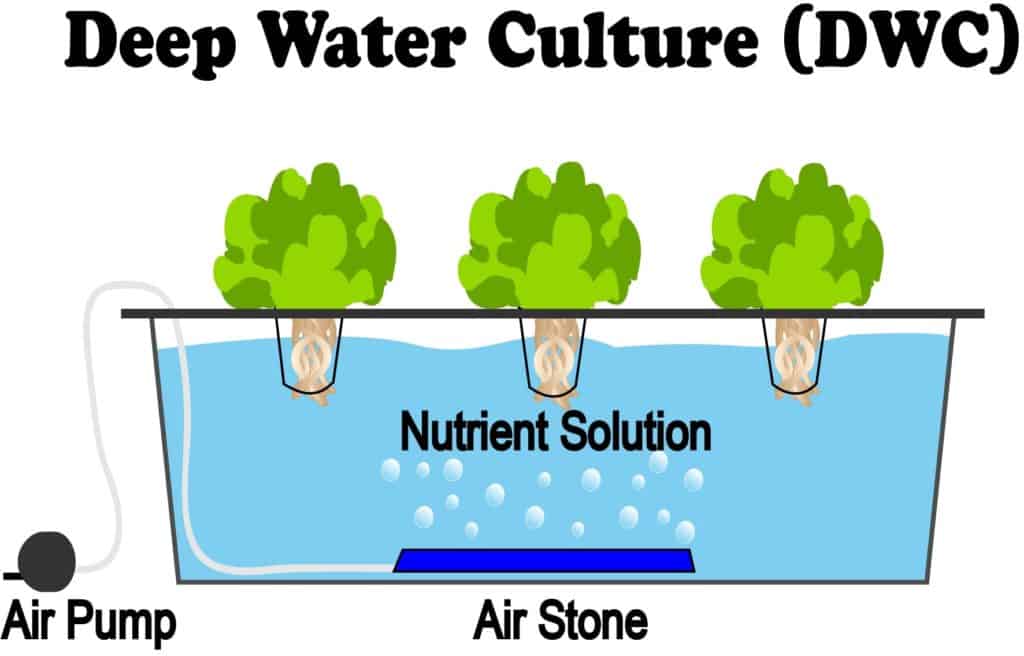
From the image, you can see that we just need the plants, nutrient solution, water, and an air stone.
Presuming you use organic plants, regular water, and any air stone is fine. Then you just need to use organic nutrient solution and you’re effectively growing plants “organically” to most regular folks.
How To Grow Hydroponics Organically
Knowing that hydroponics cannot be called Certified Organic according to the USDA, how can we grow our hydroponic fruits and vegetables organically?
Thankfully, we can do a lot that would make our organic hydroponic produce a much better option than conventional produce and even some certified organic produce. After all, certified organic produce might have been sprayed with the few approved synthetic substances.
Start With Organic Seeds And Plants
When growing with hydroponics, we can choose to use organic seeds and plants. This is the foundation that will ensure that the produce will also be organic when it’s ready.
If you use genetically modified organisms (GMO) seeds or plants then your produce will never be considered organic regardless of how you grow the plants.
You can purchase organic seeds from your local nursery or garden store. You can also purchase organic seeds online and they are not expensive at all. As an example, you can purchase a 16,500 organic seed pack for 40 different plants on Amazon for around $20 to $30. Click here to see what the current price is on Amazon.
Grow The Plant Organically Using Hydroponics
Growing the plant “organically” using hydroponics is actually quite simple in concept. We do not need to worry about spraying the ground with pesticides or toxic fertilizers since there is no soil. Just add nutrients to your water and you’re all set to grow hydroponically.
Now this is where people get wary since we want to make sure we’re using organic nutrients instead of conventional or synthetic ones.
Organic Nutrients
You can develop organic micro nutrients from aquaponics where you circulate fish water throughout your system. Fish waste is high in nitrogen and you can add the other nutrients you need with organic additives. However, this requires a lot of trial and error to ensure that your plants are getting the right amount of nutrients.
The challenge with hydroponics is the concentration of your nutrients. Too little and the plants will be undernourished which leads to stunted growth, deformities, and a host of other plant health issues. Too much and the plants may suffocate and die from nutrient build up.
So to get the right levels of nutrients organically requires trial and error but it is possible. Here’s a great article that goes in depth on organic hydroponics.
Harvest The Plants Organically
The easiest part for hydroponics to be considered “organic” to a regular person is the harvesting method. This holds true for most home gardeners since most people do not use preservatives on their produce when harvested. Usually the produce goes from “farm to table.”
The same can be said of most hydroponic produce grown in a person’s backyard, basement, or garage. The harvest method is simply cutting the produce and including it in your next delicious meal.
No need to use any preservatives to keep the produce fresh in order to ship it to a store where it then gets purchased and eventually used. Thankfully we cut down on all that time, fuel, and preservatives with our homegrown produce.
Does Growing Organic Hydroponic Produce Matter?
For most people, it will not matter to grow Certified Organic produce. However, health conscious home growers will want their produce to be organic in the sense that it’s natural, healthy, and free of synthetic chemicals.
Remember, only the nutrient solution needs to be changed for a hydroponic setup to be “organic” to most people. So conceptually it’s not a big change.
Benefits Of Growing Organic Hydroponics
There are some great benefits to growing your organic produce hydroponically versus in the soil. Although it might seem daunting at first to setup, the long term benefits outnumber the downsides.
1. Hydroponics Uses Less Water
First hydroponics uses less water than soil grown plants. In fact, hydroponics uses about 1-2 percent of ALL water used to grow a plant in soil. This reason alone should make most eco-conscious people want to at least attempt hydroponics.
Not to mention in some areas, water is priced higher and some local governments have implemented restrictions on when someone is allowed to water their garden. Hydroponics are largely self sustaining systems that occasionally need more water, depending on the system.
2. Hydroponics Utilize Unused Space
Hydroponics are a great way to grow in areas and spaces that you normally are not able to grow anything. Your apartment, balcony, garage, and closet are just some areas that are normally considered dead spaces.
However, all these areas can be utilized with hydroponics. In fact, a garage or room that has high ceilings can grow multiple layers of plants. This means you can grow more plants in the same square foot area than you could using soil.
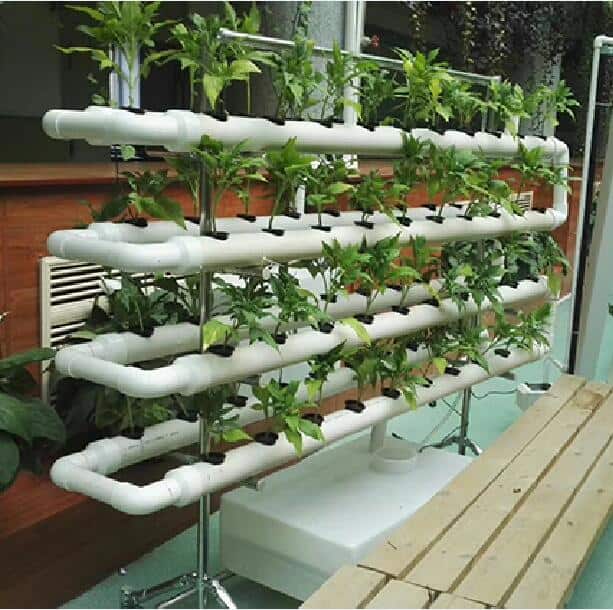
Horizontal Nutrient Film Technique (NFT) system where water flows from the top all the way through the pipe to the bottom reservoir.
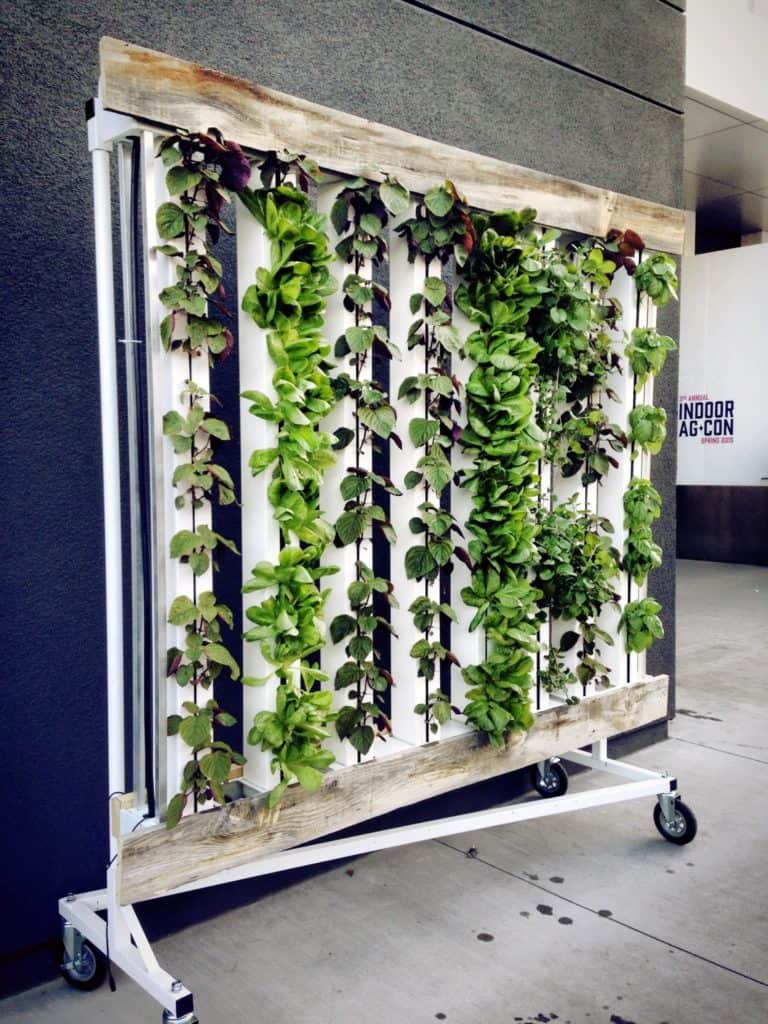
Vertical NFT system where the water flows vertically from the top to the bottom through each pipe. Each pipe consists of about 10 plants.
As you can see in the NFT systems above, you are able to grow a lot more plants in the same square foot area compared to a soil garden. Hydroponics allows you to take full advantage of any unused vertical space.
3. Plants Can Be Grown Year Round
Some regions of the world have freezing winters or scorching summers where plants cannot grow outdoors. These times are perfect for growing indoors with hydroponics since plants can thrive with regulated temperature.
Plants typically need the air temperature to be around 65 to 80 degrees which is easy to maintain in an insulated house or closet. People have also grown plants hydroponically in green houses during cold winters with the help of space heaters.
4. Hydroponic Plants Grow Faster
Hydroponic and aeroponic plants grow much faster than when planted in soil. For example, a head of lettuce will go from seedling to harvest in about 30 days with hydroponics. This same lettuce plant would take about 60 days when grown in soil.
5. No Weeds and Less Pests
One of the best reasons for growing plants with hydroponics is that there is NO weeds to pull out. No more getting on your hands and knees to keep your garden tidy since weeds have no chance of growing in your hydroponic garden.
You will also have less pests since slugs and other ground pests typically will not reach your hydroponic garden. However, you can still get airborne pests if your hydroponic plants are outdoors. Having your plants indoors reduces or eliminates the pest issue as well.
6. You Have Complete Control
Growing plants in a hydroponic setup allows you to have complete control. You get to control the nutrient levels, water cycles, and even the lighting. This means you can create the perfect environment for your plants.
Some plants prefer more nitrogen so you can adjust the nutrient balance in the water. Some plants prefer 18 hours of daylight which you can also provide. You get to provide the best conditions for your plants to thrive with hydroponics.
Downsides Of Growing Hydroponics
There are a number of great reasons to grow hydroponically but there are also some downsides. These downsides are worth considering when thinking of a hydroponic garden.
Higher Energy Consumption
Although hydroponic plants need far less water than growing in soil, hydroponic setups do require electricity to grow indoors. If you are growing with the kratky method outdoors then there will be zero energy consumption.
However, most hydroponics setups involve either water pumps, air stones, and/or grow lights. All of this means you need to use electricity to help your plants grow in your hydroponic garden.
There are a variety of ways to reduce the energy consumption of your hydroponic setup, such as using LED grow lights. There are also methods that either do not need a water pump or air stone. This allows you to keep things simple and reduce the amount of energy needed.
Limited In Plant Species
Unlike soil, not every single plant will grow in a hydroponic setup. Typically you want plants that have a shorter seed to harvest cycle such as lettuce, herbs, and even tomatoes.
You cannot plant an apple tree in a hydroponic setup and expect it to grow and produce apples. Unfortunately, plants that need years to grow need to remain in the soil. The reason is that these plants will have large or deep roots which will plug up any hydroponic system that has flowing water.
Short List Of Recommended Hydroponic Plants
There are a lot of great hydroponic plant options but here’s a short list popular plants:
- Green Veggies (Lettuce, Spinach, Kale, Bok Choy, etc.)
- Herbs (Basil, Mint, Chives, etc.)
- Strawberries
- Tomatoes – depending on the hydroponic system. Tomatoes are challenging in NFT systems
- Scallions
- Cucumbers
- Celery
- Green and Sweet Peppers
- Radishes
- Beans
The most important characteristics of all these 10 plants is that they grow relatively quickly and take up little space. There are other plants that are great for hydroponics but you want to stay away from the difficult plants unless you have the proper setup for them.
Short List Of Difficult Hydroponic Plants
Here are examples of some difficult hydroponic plants:
- Carrots
- Potatoes
- Turnips
- Pumpkins
- Corn
- Zucchinis
In this short list of challenging hydroponic plants, numbers 1 to 3 are deep root crops. The challenge with deep roots is that they can plug hydroponic systems, or in the case of potatoes, these vegetables grow in the roots. Remember your roots are usually submerged in water so this is not ideal for growing potatoes.
The plants numbered 4-6 are difficult hydroponic plants since they take up a lot of space. Pumpkins and watermelons are huge plants that sprawl out horizontally. Corn is a tall plant before it starts producing corn. These reasons make these plants difficult hydroponic plants.
Conclusion
Hydroponics is an efficient way to grow plants as you go from seed to harvest in a shorter time. It is not uncommon to have better yields, which means bigger and more tomatoes on a tomato plant through hydroponics.
However, growing hydroponics organically can be challenging just because of the nutrient solution. You will need to develop your own organic micro nutrient system in order to not use synthetic or concentrated nutrients. People frequently create biofilters when growing organic hydroponics.
There are plenty of nutrient solution on the market for hydroponics so you can find one that is organic enough to get started with hydroponics. If its something that you enjoy doing then you can setup a proper aquaponics, biofilter, or micro nutrient system to go fully organic.

